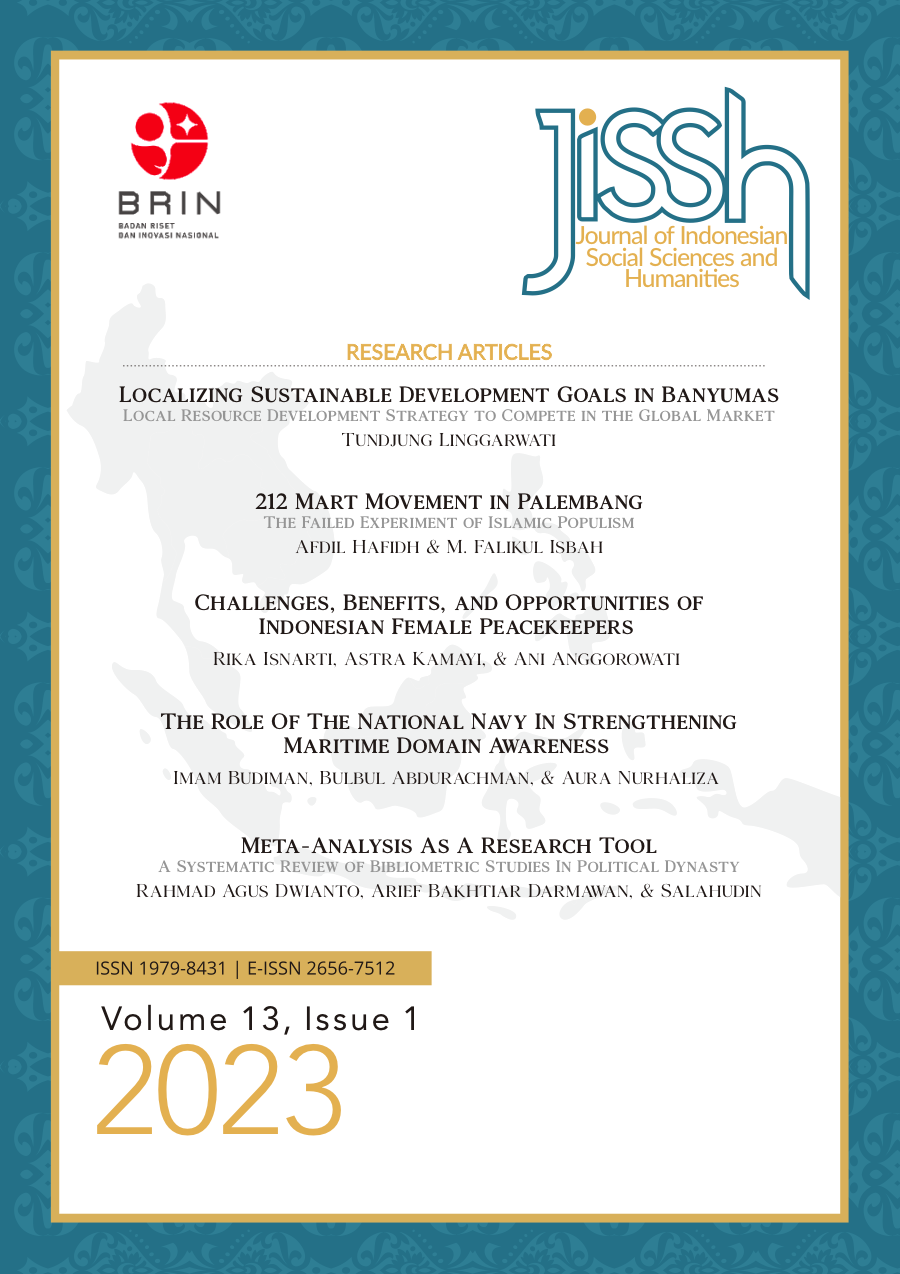The Role Of The National Navy (TNI AL) In Strengthening Maritime Domain Awareness In Indonesia
Keywords:
Role, Navy, Maritime Domain Awareness, IndonesiaAbstract
The Indonesian Navy’s National Navy (TNI AL) has an important role in strengthening maritime domain awareness (MDA). In the era of globalization, the sea has become a very vital strategic area for the country. The Indonesian Navy has a major role in guarding and protecting Indonesian territorial waters from various threats, such as terrorism, illegal trade, illegal fishing, and conflicts at sea. To carry out this role, the Indonesian Navy needs good and effective MDA instruments. In building MDA, the Indonesian Navy must have the ability to collect information from various sources, be it through monitoring from the air, sea, or land. This paper uses a qualitative-descriptive method by obtaining data through a literature review process. The Indonesian Navy can utilize sea power to strengthen national defense, increase maritime trade, and secure marine resources. In this case, the Indonesian Navy can act as a protector of national security and also as a driver of economic growth through the maritime sector. In conclusion, TNI-AL plays a very important role in maritime domain awareness. For this reason, the TNI AL needs to have good and effective MDA instruments for gathering information and taking appropriate action. By having this capability, the Indonesian Navy can strengthen national defense and exploit the potential of the sea for the country’s economic progress.
References
Agastia, I. G. B. D dan Perwita, A. A. B. 2018. Building Maritime Domain Awareness as an Essential Element of the Global Maritime Fulcrum: Challenges and Prospects for Indonesia’s Maritime Security. Jurnal Hubungan Internasional Vol. 6 Edisi 1.
Ali, A. H. (n.d.). Forum Kajian Pertahanan Maritim. Diakses dari Forum Kajian Pertahanan Maritim: https://fkpmar.org/tantangan-penerapan-maritime-domain- awareness-di-indonesia/
Aprianto, I Nengah Putra. Dhaniswari, A. M., & Rakhmagina, N. (n.d.). TANTANGAN DARI VISI ‘POROS MARITIM DUNIA’ DALAM RANGKA MENINGKATKAN LAJU EKONOMI MARITIM DI INDONESIA.
Santoso, D., & Nafisah, F. (2018). Indonesia’s Global Maritime Axis Doctrine: Security Concerns and Recommendations. Jurnal Hubungan Internasional, 10(2), 191. https://doi.org/10.20473/jhi.v10i2.7306
2018. Information Technology Design Tni Al Guna Mendukung Strategi Pertahanan Laut Nusantara. Surabaya: CV. Bintang (Penerbit Bintang Surabaya).
Buerger, C. 2015. From Dusk to Dawn? Maritime Domain Awareness in Southeast Asia. Contemporary Southeast Asia. Vol 37(2). pp. 157-182.
Darono, P. (n.d.). TNI Angkatan Laut sebagai World Class Navy pada Strategi Pertahanan Indonesia dalam Mewujudkan Poros Mari. Gema Keadilan Edisi Jurnal, 195-215.
Departmen of The Navy US. 2007. Navy Maritime Domain Awareness Concept. Washington DC.
Haras , Yusrah Muhammad. 2017. Peran TNI AL Dalam Mendukung Terwujudnya Indonesia Sebagai Poros Maritim Dunia Perspektif Manajemen Pertahanan. Jurnal Prodi Manajemen Pertahanan.
Hutomo, M. S. (2020, 5 Februari). Indomaritim. Retrieved from Indomaritim: https://indomaritim.id/marsetio-sea-power-jadi-modal-menyongsong-indonesia-gemilang-2045/Kompas.com. 2020. Ini Peran dan Tugas TNI AL dalam Mewujudkan Gagasan Poros Maritim Dunia. Diakses pada https://nasional.kompas.com/read/2020/09/22/07120731/ini-peran-dan-tugas-tni-al-dalam-mewujudkan-gagasan-poros-maritim-dunia
Marsetio. 2013. Strategi Tni Angkatan Laut Dalam Pengamanan Batas Maritim Nkri: Kajian Historis-Strategis. Jurnal Sejarah Citra Lekha, 1-18.
Marsetio. 2013. Membangun Maritime Domain Awareness Guna Mendukung Keamanan Maritim dalam Perspektif TNI Angkatan Laut. Jurnal Pertahanan. Vol 3 (3): pp. 4-6.
Marsetio. 2014. Sea Power Indonesia.
Marsetio. 2016. Aktualisasi Peran Pengawasan Wilayah Laut Dalam Mendukung Pembangunan Indonesia Sebagai Negara Maritim Yang Tangguh. Diakses pada https://fri2016.uny.ac.id/sites/fri2016.uny.ac.id/files/5A2.%20MAKALAH%20%20DR.%20MARSETIO.pdf
Muhaimin, R. 2018. The Policy Of Securitization and Threat Perception In The North Natuna Sea. Politica, 17-37.
Prabowo, Angga Reza. 2022. Institusionalisasi Pembangunan Maritime Domain Awareness (MDA) Pada Kebijakan Pemerintah Tahun 2014-2022. https://doi.org/10.47266/bwp.v5i3.190
Rivaldi Ananda Dwi Putra, E. N. 2021. Strategi Maritime Domain Awareness Dalam Meningkatkan Ekonomi Berkelanjutan Di Kabupaten Belu. Semesta, 84-90.
Setyawati, L.R, dkk. 2021. Implementation of Sea Power and Maritime Domain Awareness (MDA) in Indonesia to Strengthening National Vigilance in the South China Sea. International Journal of Innovative Science and Research Technology.
Sinuraya, T. S. (n.d.). Topik Maritime Domain Awareness Concept .
Sulistiawan, A. (2020, 6 Juni). Maritimnews. Retrieved from Maritimnews: http://maritimnews.com/2020/06/guru-besar-pertahanan-jabarkan-cara- merancang-world-class-navy-dengan-ssm-based-ar/
Supandi, A. 2015. The Indonesian Navy Force Planning To Support Indonesian Vision As World’s Maritime Fulcrum. Jurnal Pertahanan , 1-24.
TNI Mil id. 2016. Laksamana TNI (Purn) Dr. Marsetio Beri Kuliah Umum “Maritime Domain Awareness Mahasiswa STTAL. Diakses pada https://tni.mil.id/view-102756-laksamana-tni-purn-dr-marsetio-beri-kuliah-umum-maritime-domain-awareness-mahasiswa-sttal.html
Widyoutomo, Antonius. 2022. Pengamanan Laut Mewujudkan Keamanan Maritim Indonesia . Tentara Nasional Indonesia Angkatan Laut Sekolah Staf Dan Komando. Diakses pada https://seskoal.ac.id/assets/brangkas/Makalah_Indonesia_FINAL.pdf.
Wreski dan Lavoie. 2017. Thesis A Concept Of Operations For An Unclassified Common Operational Picture In Support Of Maritime Domain Awareness. Naval Postgraduate School Monterey, California.
Downloads
Published
Issue
Section
License

This work is licensed under a Creative Commons Attribution-ShareAlike 4.0 International License.
Authors who publish with this journal agree to the following terms:
1. Authors retain copyright and grant the journal right of first publication with the work simultaneously licensed under an Attribution-ShareAlike 4.0 International (CC BY-SA 4.0) license. This license allows others to remix, adapt, and build upon the work, as long as they credit the author and license their new creations under the same terms.
2. Authors may enter into separate, additional contractual arrangements for the non-exclusive distribution of the journal’s published version of the work (e.g., posting it to an institutional repository or including it in a book), provided there is an acknowledgment of its initial publication in this journal.
3. Authors are permitted and encouraged to post their work online (e.g., in institutional repositories or on their personal website) prior to and during the submission process, as this can lead to productive exchanges and increase citations of the published work (See The Effect of Open Access ).


















